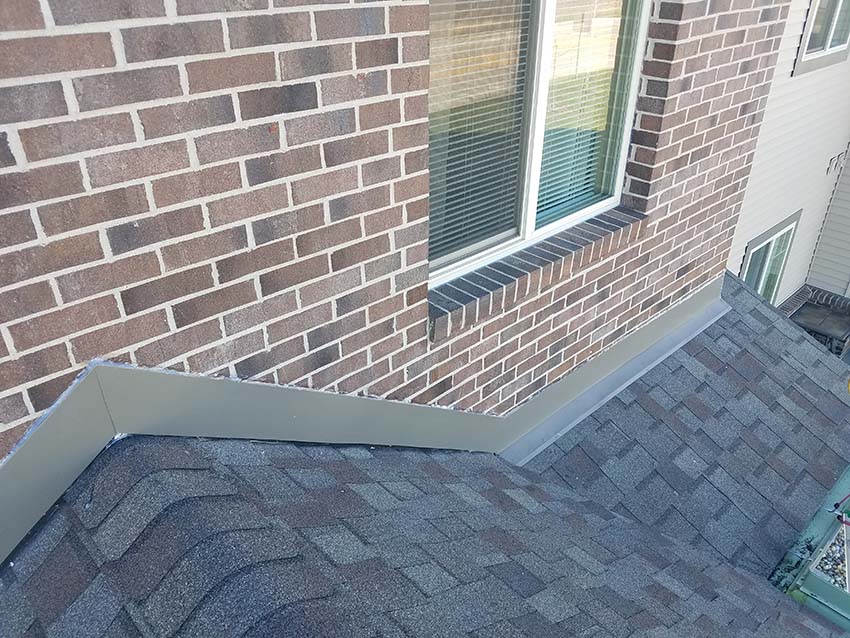ROOF FLASHING: ITS ROLE AND IMPORTANCE

As a homeowner, it is essential to know the parts that make up your roofing system so you know how to properly maintain your roof and make sure that it functions perfectly. In the previous blogs, we have discussed different components that make up a roofing structure like the underlayment, gutter and gutter guards as well as their importance.
Roof shingles make up most of a roofing structure but they cannot fully function on their own. Your roof is mainly there to protect you and your family from elements, and it would take more than just your shingles to do that. This is where roof flashing comes to the rescue.
Roof Flashing and Its Importance
Flashing are thin metal strips that are installed to secure susceptible points of leaking around the roof. They function by connecting various roofing components which can be overlapped and connected with one another to seal any open space which may serve as entry to water and other elements that could cause damage to your home.
Breaks on the roofing plane are the weakest and most vulnerable points of the roof. Flashing is placed around areas of the roof’s surface where there are punctures and joints. These punctures and joints create opportunity for water to get into other parts of your roofing system and inside your home that may cause greater damage than you can imagine. Joints are points where two slopes meet. Installation of skylights, vents, chimneys and solar panels, on the other hand, are some of the perfect examples for puncturing the roof where flashing is also most needed.
Since it plays a vital role in keeping your roof’s health, making sure it functions properly, flashing needs to be correctly installed and kept in good condition. With sufficient flashing, water is directed away from the vulnerable points of your roof and straight into the gutters. Without flashing, leaking is just around the corner, waiting to happen.
Types of Flashing and Their Functions
- Drip Edge. Also known as Eaves Strip, this is a metal flashing that runs under the roof along the eaves of your house that helps support the roofing which extends past the roof deck. It overhangs the sides of the roof and has a small metal flange that is bent to direct the rainwater away from the fascia and into the gutter, protecting the underlying roofing components.
- Valley Flashing. This is the most common type of flashing and is found on the intersection between two roof planes. This flashing functions as a dam which leads rainwater away from the roof’s plane edges.
- Vent Pipe Flashing. These are flashing found at the base of protrusions like vent pipes. It seals the area around the vent pipes to protect water or moisture intrusion.
- Step and Continuous Flashing. Both Flashing’s protect areas where the roof meets with a vertical structure like that of a wall or chimney. Step flashing is used on surfaces perpendicular to the roof while continuous flashing is used on surfaces parallel to the roof.
Now we know that roof flashing is a very critical part of your roofing system. It provides protection to different areas of your roof and it works in conjunction with other roofing materials. These strips keep your roof waterproof by sealing areas of your roof that are most susceptible to water intrusion, not to mention it adds to your roof’s clean look.
Aside from proper and adequate installation, regular inspection by your trusted local roofing contractor is important to make sure that all flashing is secure and in proper condition. Misplaced and damaged flashing give perfect opportunity for water to seep into the parts of your roof and your home that are more vulnerable to damage.
If you want to know more about flashing installation and how you and your roof will benefit from it, All Weather Exteriors is a roofing contractor that can help you! We are the best when it comes to Winnipeg roofing and our master roofers will be able to help you with all your roofing needs.
If you are from Winnipeg and you are having issues with your roof and home exteriors, we can’t wait to talk to you! Let our team of professionals help you be worry-free from leaking problems that the rainy days can bring you.
Give us a call: (204) 510 2959
Drop us a line: info@allweatherexteriors.ca
Photo Credits: www.veraroofingandconstruction.com

Leave a Reply
You must be logged in to post a comment.